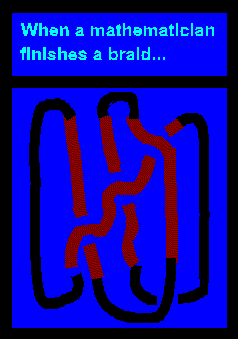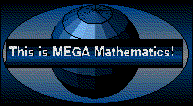
Mathematicians "finish" a braid differently, even if it is only in their imagination.
When you are finished weaving braid as a mathematician (instead of a hairdresser!), pair up ends and join them in the same way that you join the two free ends of rope when you finish a knot. The more strands the braid has the more possible ways there are to join the ends. How could you keep track of this?
If you make some braids and finish them in a variety of ways, pairing different ends each time, you will find that sometimes the braid finishes into a single knot, and other times, the braid finishes into two or more knots that are looped into each other. When more than one knot is connected or looped into each other, the resulting mathematical object is called a link.
If you have a braid made up of 4 strands, can you find a way to join the ends to form a link with two knots in it? Three? Four? More than four?



 Whether you
braid 3 strands in a person's hair, or braid many strands of thread
for a friendship bracelet, or braid lengths of twine to make a rope, or
braid several strands of dough to make an ornamental loaf of bread, you
will probably combine the braid components in some kind of pattern.
Mathematicians consider all combinations of braid components when
they study braids, and not just the ones that make obvious patterns.
Whether you
braid 3 strands in a person's hair, or braid many strands of thread
for a friendship bracelet, or braid lengths of twine to make a rope, or
braid several strands of dough to make an ornamental loaf of bread, you
will probably combine the braid components in some kind of pattern.
Mathematicians consider all combinations of braid components when
they study braids, and not just the ones that make obvious patterns.